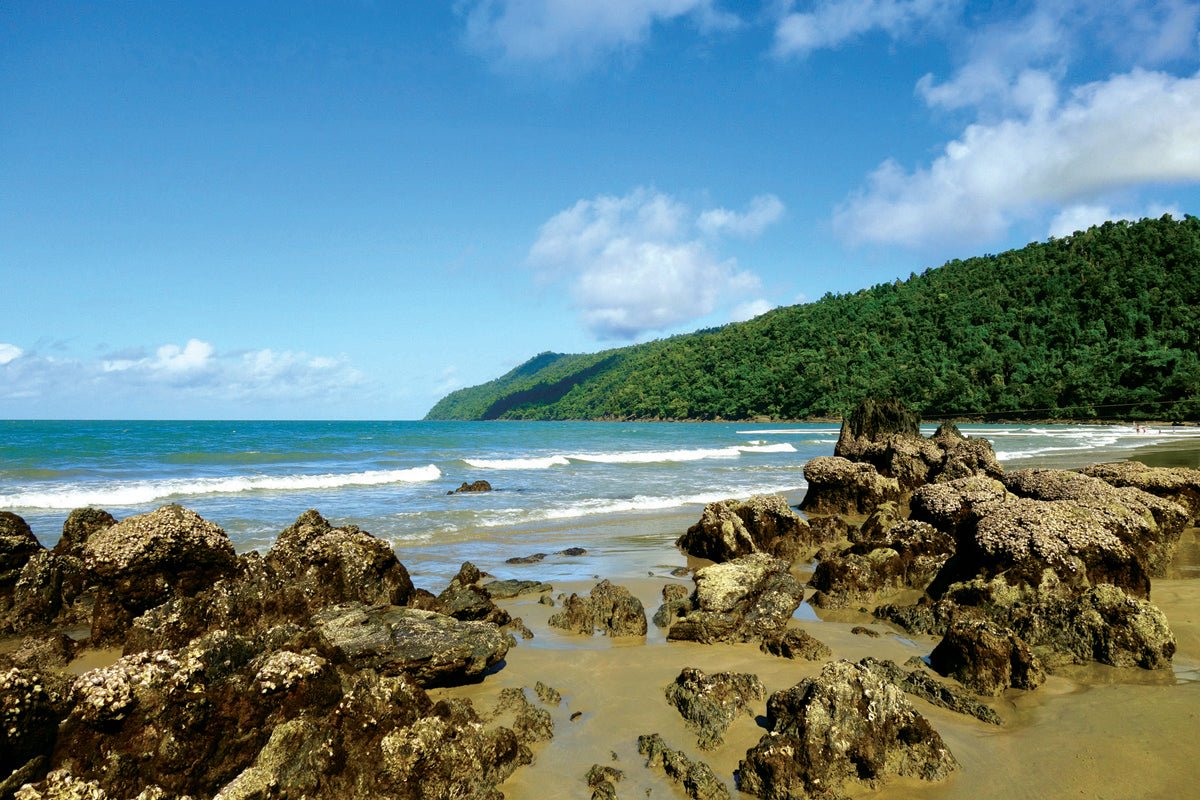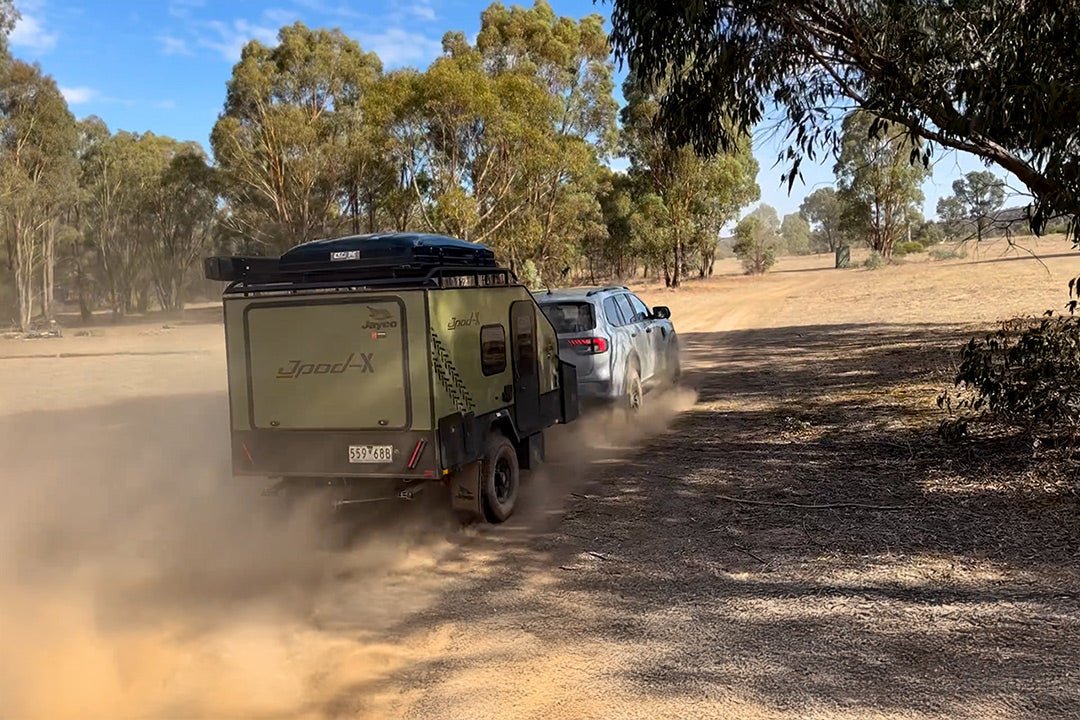Tropical Treasures

The tourism capital of Queensland’s far north sits on the western bank of Trinity Inlet, a meandering tidal estuary flowing into the Coral Sea sprinkled with yachts and flanked by green mountains. To its north lies the World Heritage Daintree, the world’s oldest rainforest, while to its east is another World Heritage wonder in the sprawling and technicolour Great Barrier Reef.
Such abundant natural beauty has made Cairns a launchpad for a plethora of tours, from island cruises to white-water rafting, Indigenous cultural experiences and even a historic railway. But while reef and rainforest often dominate the story here, there are other lesser-known treasures worth exploring.
GRANITE GORGE
An hour and 15 minute drive inland to Granite Gorge sees a shift from lush rainforest to dry savannah. A maze of enormous boulders cut by Granite Creek, Granite Gorge’s terrain makes a fantastic playground for hiking and swimming. But its most famous attraction is a colony of sociable Mareeba rock wallabies that not only feed right from your hand but will likely sit in your lap too. The gorge is on private property and though these pint size furry creatures are entirely wild and free to wander, they have become accustomed to humans and handfeeding them the approved pellets provided is a real treat.
Several short hiking trails wind between and over the boulders, offering some striking views across the Atherton Tablelands. A side trip to Whale Rock is quite a scramble, marked by painted red dots that guide walkers past a wonderland of palms, streams and a string of well-defined dinosaur footprints embedded in the rock. There are also dozens of turtles to be found loitering at the weir, hoping to score a few wallaby pellets.
Expansive shaded campgrounds are onsite and just a short walk from crocodile-free swimming and canoeing. Though there is plenty of wildlife in the area, the owners also have an extensive collection of ‘pets’ that include lizards, snakes, birds and a particularly friendly ring-necked parakeet.
ETTY BAY
There is something magical about a bird that stands up to two metres tall, has a horn on its head, flouncy black plumage and a bright blue and red neck. The southern cassowary is Australia’s heaviest bird, weighing up to 76kg, yet despite its size and bright colouring it’s often difficult to spot.
Mission Beach and the Daintree are popular locations to try and see one of these birds but at Etty Bay you’re almost guaranteed. Situated at the end of a dead-end road a 90-minute drive south of Cairns, Etty Bay is enclosed by the rainforested Moresby Range that cascades steeply to a 700m sweep of white sand. It’s perhaps this relative isolation and reduced traffic that has allowed the cassowary population here to flourish.
Early morning and late afternoon are the best times to spot these impressive birds as they forage for food on the beach or between tents and vans at the waterfront caravan park. This lack of shyness often makes for some pretty special encounters but it’s best to give the birds their space. Each of their three-toed feet bears a dagger-shaped claw up to 12cm in length that can inflict serious injuries if they feel threatened.
Apart from wildlife spotting, a stinger net and surf lifesavers make the bay relatively safe for swimming. Fishing is best at high tide from the rocks at either end of the beach.
CHILLAGOE
Chillagoe was once a thriving base for mining, but its main draw now are the 600 odd caves scattered throughout the karst system of Chillagoe-Mungana Caves National Park. The inland sea that existed here 400 million years ago deposited layers of mud, coral reefs and organisms, and over the years, these hard layers were tilted and eroded, creating spectacular formations both above and below ground.
The caves are abundant with stalactites, stalagmites and flowstones, and provide a home to colonies of bats, swiftlets (similar to swallows), insects and the odd spotted python. You’ll need a head torch for some of the self-guided caves — such as Archways, Pompeii and Bauhinia — but the sense of discovery will leave you feeling like a real explorer. Alternatively, ranger-guided tours navigate Donna, Trezkinn and Royal Arch caves, where walkways and lighting make movement a little easier, but there are still plenty of steps, ladders and tight squeezes to negotiate. Royal Arch cave is the biggest, stretching around 1.5km through 13 chambers.
A 15km drive west of Chillagoe leads to Mungana and the Archways cave system where delicate ripples of limestone are interspersed with treeroots from above. The occasional collapsed ceiling shines light into cavernous rooms.
Above ground there are numerous excellent walks in the park, from short strolls to 9km hikes, taking in some spectacular features. Balancing Rock teeters around eight metres over any walkers skirting beneath it, the Wullumba Aboriginal rock art site can be found on the Royal Arch track and Royal Arch Bluff is a striking thrust of jagged limestone rising from the surrounding woodland.
BABINDA BOULDERS
There are few swimming holes around the Cairns region more idyllic than Babinda Boulders. The Babinda Creek cascades into crystal clear emerald pools overhung with rainforest and vines. The flow comes from Mt Bartle Frere, Queensland’s highest mountain, a mere seven kilometres away, so there’s not much to taint its purity.
Annual rainfall here is some of the highest in the country and over aeons water has worn the surrounding rock into beautifully sculpted curves and holes best viewed from the walking track to Boulders Gorge lookout. This sealed path is 600m long and goes via the Devil’s Pool Lookout.
Those wanting to stretch their legs can embark on the 19km Goldfields Trail that starts at the Boulders. This rough track, which slides between Mt Bartle Frere and Bellenden Ker, is a hotspot for the strikingly large king fern. Even if you only venture 100m up this track, you’ll find a beautiful and far less visited swimming hole with huge rounded boulders to enjoy.
With no crocodiles to worry about, and gas BBQ’s and picnic tables provided, this is a popular hangout with the locals.
CATTANA WETLANDS
What were once cane fields and a sand quarry have been restored into a thriving wetland area, providing habitat for abundant birds and animals. Over several decades, volunteers planted over 100,000 trees while quarry pits filled to become lily-filled lakes. This rehabilitated land complemented 30 hectares of existing remnant lowland rainforest to create what is now a special pocket of nature.
Despite being just a 20-minute drive north of Cairns, the reserve, which opened to the public in 2009, has largely escaped tourism’s attention. A network of trails wind through the wetlands, dotted with park benches that invite wildlife-watching or quiet contemplation. Birders will have a field day spotting the abundant species, including kingfishers, black-necked storks (Jabiru), jacanas, crimson finches and dozens more, that call it home. For the serious birdwatcher, several hides offer a place to stake out the vast lakes lined with melaleucas.
Butterflies are a real treat here and you’re bound to spot plenty of the dazzling electric blue Ulysses. It’s estimated that around 40 species of butterfly live in these wetlands, along with dragonflies and cicadas.
If you follow the boardwalks through the Feather Palm forest, you’ll cross some streams where fish and eels linger in the shadows.
Despite its tamed past, Cattana is now a rich nature immersion experience with life at every level. Those that linger and observe will be rewarded with some excellent sightings.
FAST FACTS
GRANITE GORGE
Just over an hour inland from Cairns are the dry Savannah landscapes of Granite Gorge, a playground of huge boulders where you can hand-feed rock wallabies and swim in the shaded Granite Creek. Day admission to the gorge is $13 per adult. A bag of wallaby food costs $1.
Where to stay: Granite Gorge Caravan Park has a range of camping and cabin options in a shaded bush setting. Facilities are modern and pets are allowed (on lead) in the camping area.
granitegorge.com.au
ETTY BAY
Wild cassowaries roam freely at Etty Bay providing almost guaranteed close encounters with Australia’s heaviest bird. Slow down when driving in cassowary territory. Never feed them and ensure food scraps are secured in closed bins. Mobile reception here is limited.
Where to stay: Etty Bay Cabins & Caravan Park is in prime position, right on the waterfront. There is a fish and chip shop (open Thu–Sun) plus a small general store that provides a few basic groceries but it’s best to do your shopping before arrival.
ettybaycaravanpark.com.au
CHILLAGOE
Less than three hours west of Cairns is a network of spectacular caves and rock formations at Chillagoe-Mungana Caves National Park. Wear sturdy non-slip shoes and carry a torch to explore self-guided caves or join a guided tour with Queensland Parks & Wildlife ($28.75 per adult for one cave or $57.60 for three caves). Access to the region is best via Mareeba in the Atherton Tablelands, the final 32km of which is a mix of sealed and unsealed roads that are suitable for conventional vehicles in dry weather.
Where to stay: Camping is not permitted in the national park, but you can camp on its fringes. Chillagoe Observatory & Eco Lodge is in a bush setting with plenty of wallabies and birdlife. A swimming pool and fire pits are provided.
coel.com.au
BABINDA BOULDERS
This swimmer’s paradise is nestled in the rainforest an hour’s drive south of Cairns. Take care to stick to safe swimming zones as drownings have occurred. The Boulders are easily accessed via a 6km sealed road from Babinda township.
Where to stay: Free camping is permitted at the unmanned, council-run Boulders Campground for up to three nights. Sites are unpowered but basic toilets and showers are provided.
CATTANA WETLANDS
A thriving wetland area just 20 minutes north of Cairns is home to abundant birdlife, tonnes of butterflies and fern-palm forests. Insect repellant is a must if you don’t want to lose a pint of blood to the mosquitos. Plan to spend a good few hours here to spot the wildlife, plus make use of the barbecue areas.
Where to stay: Lake Placid Tourist Park is nestled in the rainforest a 10-minute drive southwest of Cattana. lakeplacidtouristpark.com
Alternatively, 20 minutes further north, NRMA Palm Cove Holiday Park has camps just metres from the beach.
nrmaparksandresorts.com.au/palm-cove.







